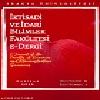ANALYSIS OF TOBACCO USE BEHAVIOUR BASED ON TURKEY HEALTH INTERVIEW SURVEY
Tobacco use, Chi-Square Analysis
___
- References
- Bozkurt A., Şahinöz S., Özçırpıcı B., Özgür S., Şahinöz T., Acemoğlu H., Saka G., Ceylan A., Palancı Y., İlçin Ersen, Akkafa F. (2006), Patterns of Active and Passive Smoking, and Associated Factors, in the South-East Anatolian Project (SEAP) Region in Turkey, BMC Public Health, Volume 6, 15
- Cook K, Bhatti L, Tursan d’Espaignet E. (2016) WHO Tobacco Knowledge Summaries: Tobacco and Stroke. WHO, Geneva, Available:https://apps.who.int/iris/bitstream/handle/10665/250278/WHO-NMH-PND-CIC-TKS-16.1-eng.pdf /Accessed on 27 June 2019
- Cramer H. (1946) Mathematical Methods of Statistics, Princeton University Press
- Çalıkoğlu E.O, Köyceğiz E. Tobacco Control Policies in Turkey in Terms of MPOWER. The Eurasian Journal of Medicine 2018; 50: DOI: 10.5152/eurasianjmed.2018.18009.
- Çelikel F.C.,Çelikel S., Erkorkmaz Ü. Smoking Determinants in Turkish University Students, 2009, International Journal of Environmental Research and Public Health, 6, 2248-2257; Doi:10.3390/ijerph6082248
- Daniel W.W. Applied Nonparametric Statistics, 1990, Second Edition, George State UniversityErdoğan N. and Erdoğan I. Smoking at School: Views of Turkish University Students, International Journal of Environmental Research and Public Health, 2009, 6, 36-50, Doi:10.3390/ijerph6010036
- GATS Turkey Report 2010, The Ministry of Health of Turkey, Ankara, ISBN: 978 - 975 - 590 - 332 -3, Ministry of Health Publication Number: 803
- GATS Turkey 2012, Public Health Institution of Turkey Ministry of Health, Publication No: 948, 2014, Ankara, ISBN: 978-975-590-502-0
- İlhan M. N., Arıkan Z., Kotan Z, Tunçoğlu T., Pınarcı M., Taşdemir A., Ay B., Koçak N. Prevalence and Socio-Demographic Determinants of Tobacco, Alcohol, Substance Use and Drug Misuse in General Population in Turkey. Arch Neuropsychiatry 2016; 53: 205-212 DOI: 10.5152/npa.2015.10050
- Öksüz E., Mutlu E.T., Malhan S. Characteristics of Daily and Occasional Smoking Among Youths, 2007, Public Health, 121, 349–356
- Öncel S.Y. Gebizlioğlu Ö.L. Alioğlu F.A. Risk factors for smoking behavior among university, 2011, Turkish Journal of Medical Sciences, 41 (6), 1071-1080
- Öztürk A., Poyrazoğlu S, Şarlı Ş (2011) The short term effect of the law prohibiting smoking in enclosed areas upon the smoking conditions of employees in Kayseri, Turkey, Turkish Journal of Medical Sciences, 41 (1), 165-171
- Palipudi K.M., Gupta P.C., Sinha D.N., Andes L.J., Asma S., McAfee T. (2012) Social Determinants of Health and Tobacco Use in Thirteen Low and Middle Income Countries: Evidence from Global Adult Tobacco Survey. PLoS ONE 7(3): e33466. Doi:10.1371/journal.pone.0033466
- Pekel Ö., Ergör G., Günay T., Baydur H, Choussein B., Budak R., Doğanay S. (2015) Smoking cessation and the effect of nicotine dependence on relapse rate in İzmir, Turkey, Turkish Journal of Medical Sciences, (2015) 45: 895-901Saatci E. , Inan S., Bozdemir N., Akpinar E., Ergun G. Predictors of smoking behavior of first year university students: Questionnaire Survey, 2004, Croatian Medical Journal, 45(1):76-79,
- Sağlam L. Investigation of the results of a smoking cessation clinic and the factors associated with success, 2012, Turkish Journal of Medical Sciences, 42 (3), 515-522
- TurkStat 2019, Turkey Health Interview Survey 2016
- Ukert B. The short- and long-run effects of smoking cessation on alcohol consumption”, International Journal of Health Economics and Management, 2017, 17:495–519 WHO 2019 b, Report on the Global Tobacco Epidemic 2019. Geneva: World Health Organization; 2019. Licence: CC BY-NC-SA 3.0 IGO. Available: https://www.who.int/tobacco/global_report/en/ Accessed on 01 August 2019
- WHO, 2019, DON’T LET TOBACCO TAKE YOUR BREATH AWAY, Choose Health Not Tobacco 31 May World No Tobacco Day) Available: https://www.who.int/campaigns/world-no-tobacco-day/world-no-tobacco-day-2019/Accessed on 27 June 2019.
- WHO, 2018b, World No Tobacco Day 2018: Tobacco breaks hearts – choose health, not tobacco. Geneva: World Health Organization; 2018 (WHO/NMH/PND/18.4). Licence: CC BY-NC-SA 3.0 IGO.
- WHO, 2018, WHO Global Report on Trends in Prevalence of Tobacco Smoking 2000–2025, second edition. Geneva: World Health Organization,Available:http://www.who.int/tobacco/publications/surveillance/trends-tobacco-smoking-second-edition/ Accessed on 25 June 2019
- Yayın Aralığı: 2
- Başlangıç: 2011
- Yayıncı: Trakya Üniversitesi İktisadi ve İdari Bilimler Fakültesi
BİR TEKSTİL İŞLETMESİNDE ÇOK ÖLÇÜTLÜ KARAR VERME YÖNTEMLERİ İLE PERSONELLERİN DEĞERLENDİRİLMESİ
Burcu TEZCAN, Tamer EREN, Evrencan ÖZCAN, Şeyda GÜR
BAĞIMSIZ DENETİMDE TERMİNOLOJİNİN ÖNEMİ: RAPOR KAVRAMININ İNCELENMESİ
ANALYSIS OF TOBACCO USE BEHAVIOUR BASED ON TURKEY HEALTH INTERVIEW SURVEY
1970’Lİ YILLARDA TÜRK DIŞ POLİTİKASINA MUHALİF BİR SİVİL TOPLUM ÖRGÜTÜ OLARAK “BARIŞ DERNEĞİ”
